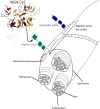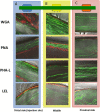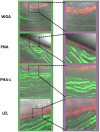Fluorescent lectins for local in vivo visualization of peripheral nerves
- PMID: 25006792
- PMCID: PMC6271788
- DOI: 10.3390/molecules19079876
Fluorescent lectins for local in vivo visualization of peripheral nerves
Abstract
Damage to peripheral nerves caused during a surgical intervention often results in function loss. Fluorescence imaging has the potential to improve intraoperative identification and preservation of these structures. However, only very few nerve targeting agents are available. This study describes the in vivo nerve staining capabilities of locally administered fluorescent lectin-analogues. To this end WGA, PNA, PHA-L and LEL were functionalized with Cy5 (λex max 640 nm; λem max 680 nm). Transfer of these imaging agents along the sciatic nerve was evaluated in Thy1-YFP mice (n = 12) after intramuscular injection. Migration from the injection site was assessed in vivo using a laboratory fluorescence scanner and ex vivo via fluorescence confocal microscopy. All four lectins showed retrograde movement and staining of the epineurium with a signal-to-muscle ratio of around two. On average, the longest transfer distance was obtained with WGA-Cy5 (0.95 cm). Since WGA also gave minimal uptake in the lymphatic system, this lectin type revealed the highest potential as a migration imaging agent to visualize nerves.
Conflict of interest statement
The authors declare no conflict of interest.
Figures







References
-
- Tewari A.K., Srivastava A., Huang M.W., Robinson B.D., Shevchuk M.M., Durand M., Sooriakumaran P., Grover S., Yadav R., Mishra N., et al. Anatomical grades of nerve sparing: A risk-stratified approach to neural-hammock sparing during robot-assisted radical prostatectomy (RARP) BJU Int. 2011;108:984–992. doi: 10.1111/j.1464-410X.2011.10565.x. - DOI - PubMed
-
- Pfister B.J., Gordon T., Loverde J.R., Kochar A.S., Mackinnon S.E., Cullen D.K. Biomedical engineering strategies for peripheral nerve repair: Surgical applications, state of the art, and future challenges. Crit. Rev. Biomed. Eng. 2011;39:81–124. doi: 10.1615/CritRevBiomedEng.v39.i2.20. - DOI - PubMed
Publication types
MeSH terms
Substances
Grants and funding
LinkOut - more resources
Full Text Sources
Other Literature Sources
Miscellaneous

